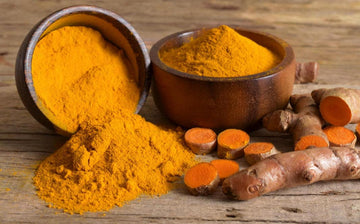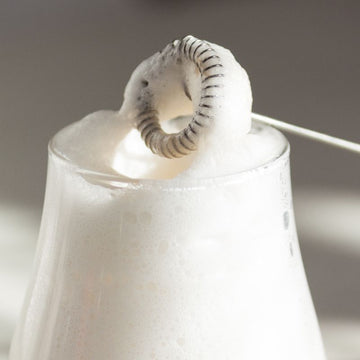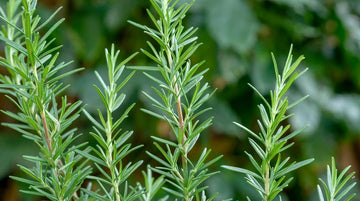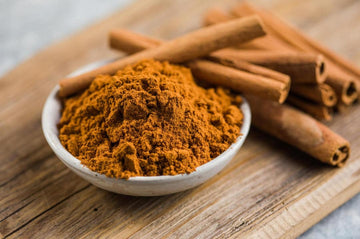Rosemary spice is one of those ingredients that doesn’t try to blend in. And that’s exactly why it’s loved. With its piney aroma and slightly bitter, woodsy flavor, rosemary brings structure and sharpness to everything from roasted meats to baked breads. Whether you're using fresh sprigs or dried leaves, rosemary doesn't sit quietly in the background, it shows up with purpose.
This article takes a closer look at what rosemary spice actually is, how it’s prepared, where it fits in your cooking, and why it’s more than just a fragrant garnish.
What is rosemary, and what are rosemary spices?
Rosemary (Salvia rosmarinus) is a woody, evergreen herb native to the Mediterranean region. It grows as a shrub, with narrow, needle-like leaves and a strong, fragrant scent that’s often compared to pine, eucalyptus, or even camphor. While the plant itself can be used fresh in cooking or teas, rosemary spice typically refers to the dried and sometimes ground version of the leaves used as a seasoning.
In its dried form, rosemary becomes more concentrated and brittle, making it ideal for long-cooking dishes like stews, braises, and roasts. Ground rosemary, essentially the dried leaves processed into a fine powder, is also available for recipes that need a smoother texture or quicker infusion of flavor.
Unlike herbs that fade into the background, rosemary tends to stand out. It’s not used for subtlety. It’s used when you want that distinct herbal edge to come through clearly in the final dish.
How to prepare rosemary spice
Preparing rosemary spice starts with selecting the right kind of rosemary. Ideally fresh sprigs that are free from mold, browning, or excessive drying. If you're starting with fresh rosemary from your garden or the store, you’ll need to dry it before turning it into a usable spice for long-term storage or cooking.

Drying fresh rosemary
There are a few common methods to dry rosemary:
-
Air Drying: Tie the sprigs together at the base with kitchen twine and hang them upside down in a warm, dry area with good air circulation. This can take up to two weeks, depending on humidity.
-
Oven Drying: Place the rosemary on a baking sheet and dry it in the oven at the lowest temperature (around 180°F or 80°C) for 2–4 hours. Turn the sprigs occasionally to dry them evenly.
-
Dehydrator: If you have a food dehydrator, this is the most consistent method. Set it to around 95–115°F and dry the rosemary until the leaves are crisp.
Once dried, strip the leaves from the woody stems and store them whole in an airtight container away from heat and light. Whole dried leaves retain flavor longer than ground spice.
How to ground rosemary spice
Dried rosemary can be tough and needle-like, which isn’t ideal in every recipe. To make it easier to incorporate into finer dishes or rubs, you can grind it into a powder.
Here’s how:
-
Use a spice grinder: Place a small handful of dried rosemary leaves into the grinder. Pulse until it reaches a fine, sand-like texture.
-
Mortar and pestle: If you prefer a more hands-on approach, crush the dried leaves manually. This takes longer but gives you control over the texture.
-
Sift if needed: For a smoother consistency, especially if using in baked goods or delicate sauces, sift the ground rosemary through a fine mesh to remove any coarse bits.
Ground rosemary spice should be stored in a tightly sealed container and used within 6 to 12 months for peak flavor. Always label your jars with the date so you can keep track of freshness.
Rosemary spice uses (both dried and fresh)
Rosemary is one of those herbs that can do more than just season. It can transform a dish. Its bold, resinous flavor holds up well to high heat and long cooking times, making it especially popular in roasted and slow-cooked recipes. Depending on whether you're working with fresh sprigs or dried leaves, the way you use rosemary might change slightly.

Uses for dried rosemary
Dried rosemary is concentrated and more brittle than fresh, so it works best in dishes where it has time to soften and release its oils:
-
Roasted Meats and Vegetables: Sprinkle dried rosemary on chicken, lamb, pork, or potatoes before roasting to infuse everything with an earthy, piney note.
-
Soups and Stews: Add early in the cooking process so the herb has time to mellow and blend into the broth.
-
Marinades and Dry Rubs: Combine with salt, pepper, garlic powder, and other herbs for a flavorful meat rub or marinade base.
-
Homemade Bread and Crackers: Add to dough for focaccia, savory biscuits, or crisp crackers. Ground rosemary works especially well here for even flavor.
-
Infused Oils and Vinegars: Dried rosemary can be steeped in olive oil or vinegar to create herb-infused condiments with long shelf life.
Uses for fresh rosemary
Fresh rosemary offers a brighter, slightly less bitter flavor than dried and is ideal for quick-cooking dishes or finishing touches:
-
Grilled Foods: Toss fresh sprigs onto hot coals for aromatic smoke, or use as skewers for meat and vegetables.
-
Compound Butters and Finishing Oils: Chop finely and mix into butter or oil to serve over steak, bread, or roasted vegetables.
-
Cocktails and Teas: Muddle fresh rosemary into gin-based drinks or steep in hot water with lemon for a simple herbal tea.
-
Garnishes: Use small sprigs as a decorative and aromatic garnish for meats, cheese boards, or even desserts like shortbread or lemon cake.
-
Braising and Pan Sauces: Add whole sprigs to the pan while cooking to infuse meats and sauces with deep flavor. Just remember to remove the woody stem before serving.
Both fresh and dried rosemary can hold their own in bold dishes. While dried is more intense and shelf-stable, fresh rosemary shines when you want that lifted, aromatic edge right at the finish. The best choice often comes down to how long the dish cooks and how much texture you want to include.
Health benefits of rosemary spice
Beyond its distinctive flavor and aroma, rosemary spice has a long history of use in traditional medicine. While it's not a cure-all, it does contain a variety of compounds that may offer real health benefits when consumed as part of a balanced diet. Most of these benefits come from the plant’s natural antioxidants, anti-inflammatory agents, and essential oils.
Rich in antioxidants
Rosemary contains several antioxidants, including carnosic acid, rosmarinic acid, and vitamin E. These compounds help protect the body’s cells from oxidative stress caused by free radicals, which are linked to aging and chronic diseases such as heart disease and cancer.
Anti-inflammatory properties
The compounds found in rosemary may help reduce inflammation in the body. Carnosol and carnosic acid, in particular, have been studied for their potential to block inflammatory pathways at the cellular level, which could support joint health and reduce symptoms associated with chronic inflammation.
May support brain function
Traditionally, rosemary has been associated with memory and concentration. Some studies suggest that even the scent of rosemary oil may help improve cognitive performance and alertness. Compounds like rosmarinic acid may also protect brain cells from age-related damage, though more research is needed in this area.
Antimicrobial effects
Rosemary has natural antimicrobial properties that can inhibit the growth of certain bacteria and fungi. This is one reason it's sometimes used in food preservation and natural cleaning products. Internally, these properties may help support a healthy gut microbiome, although more research is required to confirm consistent results.
Supports digestion
In herbal medicine, rosemary has often been used to ease digestive discomfort. It may help stimulate bile production, which supports the breakdown of fats during digestion. Sipping rosemary tea after meals is a traditional remedy for bloating and gas.
May help balance blood sugar
Preliminary studies suggest rosemary extract may have a mild blood sugar-lowering effect, which could be helpful in managing insulin resistance or type 2 diabetes. However, these findings are mostly based on concentrated extracts, not culinary doses, so it's not a substitute for medical treatment.
While rosemary spice isn’t a miracle ingredient, it does offer real, measurable benefits when used regularly in cooking. As with any herb or supplement, moderation is key. And the most effective way to use rosemary for health is simply to make it part of a varied, whole-foods-based diet.
Fresh vs. dried rosemary spice
Fresh and dried rosemary both bring the same unmistakable flavor profile to a dish. They are earthy, piney, slightly minty, but they behave quite differently in the kitchen. Understanding how they differ can help you get the most out of whichever one you have on hand.
Fresh rosemary has a livelier, more aromatic presence. The leaves are soft, green, and full of natural oils that release quickly when chopped or bruised. It works especially well in recipes that cook quickly, like grilled vegetables, pan-seared meats, or herb butters. It also makes a striking garnish. However, fresh rosemary is perishable. It typically lasts about a week or two in the fridge if stored properly, and it can be harder to find or more expensive depending on the season.
Dried rosemary, on the other hand, is more intense and concentrated. The leaves become brittle and sharp, which can make them feel a bit tough if not properly softened during cooking. This form is ideal for slow-cooked meals like stews, braises, and roasts, where it has time to rehydrate and infuse deeply into the dish. Dried rosemary is convenient, shelf-stable for up to a year, and easy to keep in the pantry. However, it can overpower a recipe if used in the same quantity as fresh.
When substituting one for the other, the general ratio is 1:3. One part dried rosemary equals about three parts fresh. Still, it's always best to taste and adjust as needed based on the dish you're preparing.
-
Flavor:
-
Fresh = Brighter and more subtle
-
Dried = Stronger, more concentrated
-
Texture:
-
Fresh = Tender
-
Dried = Coarse and brittle
-
Shelf Life:
-
Fresh = 1–2 weeks in fridge
-
Dried = 6–12 months in pantry
-
Best Used For:
-
Fresh = Garnishes, quick-cook dishes, herb butters
-
Dried = Roasts, soups, stews, bread doughs
-
Substitution Ratio: 1 teaspoon dried = 1 tablespoon fresh
Choosing between fresh and dried rosemary comes down to what you're cooking, how long it's cooking for, and the kind of texture and flavor you want in the final dish.
Rosemary spice vs. other popular household spices
Rosemary stands apart from many common household spices. Not just in flavor, but in how and when it’s used. While other spices often aim to blend in or support, rosemary usually takes a leading role. It’s more herbal than spicy, more aromatic than subtle, and more about depth than heat.
Compared to thyme, which is soft and slightly floral, rosemary is sharper and more pine-like. The two are often paired together, especially in roasted dishes, but rosemary tends to dominate the flavor profile. Oregano shares some of rosemary’s earthiness but leans more bitter and peppery, making it better suited for tomato-based sauces and Mediterranean-style dishes.
When it comes to basil, the contrast is even more pronounced. Basil is sweet, tender, and often used fresh in raw or lightly cooked dishes like salads and pestos. Rosemary, by contrast, holds up best to heat and long cooking times. Sage might be rosemary’s closest cousin in terms of intensity and pairing. Both are bold, woodsy herbs that work well with roasted meats, root vegetables, and hearty stuffings. Still, sage is softer and more savory, while rosemary cuts through with its distinctive resinous punch.
Rosemary also differs from true spices like cumin, paprika, or cinnamon, which are seeds, fruits, or bark rather than leaves. These spices tend to add warmth, smokiness, or sweetness. These are qualities rosemary doesn't offer. Instead, rosemary brings structure, astringency, and clarity. It doesn’t melt into a dish, it holds its shape and asserts its presence.
-
Thyme: milder, blends easily, floral
-
Oregano: more bitter, peppery, bold
-
Basil: sweet, soft, better raw or lightly cooked
-
Sage: earthy and savory, less sharp than rosemary
-
Cumin / Paprika / Cinnamon: add warmth or spice, not herbal; used differently
In short, rosemary is best used when you want an herb that doesn’t disappear in the background. It’s not for every dish, but when used right, it adds a defining character that’s hard to replace.
A strong herb with a specific role
Rosemary spice doesn’t try to be everything. Instead, it does one thing very well: it brings bold, aromatic structure to dishes that can handle it. Whether you’re roasting a chicken, baking a loaf of bread, or simmering a stew, rosemary holds its shape, both in flavor and texture.
Knowing when to use fresh or dried, how to prepare it, and how it compares to other household spices gives you more control in the kitchen, and better results on the plate. Keep a jar of dried rosemary in the pantry and a fresh sprig or two in the fridge when possible. It may not go into every meal, but when the dish calls for it, there’s really no substitute.










